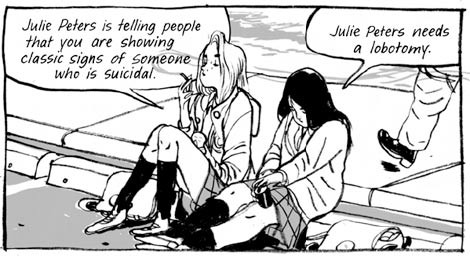In the Blog
The Governor General needs to read “Understanding Comics”

Image from Drawn: In the Studio with Jillian Tamaki Jillian Tamaki
According to today’s Globe and Mail, Skim, one of my favorite comics of the year is up for Governor General’s award. Exciting and wonderful as that is, there is a problem in that the book’s text-author Mariko Tamaki was nominated in the text category, but not the book’s other author and illustrator Jillian Tamaki.
The independent comics community has rallied in support of the Tamakis, writing an open letter to the Governor General, which explains that text, image and authorship are not so easily separated in the world of comics, and asking for the inclusion of Jillian as illustrator on the Tamaki ticket. Names in support of the Tamaki’s include Art Speigelman, Chris Ware, Lynda Barry, Julie Doucet, Michel Rabagliati and Adrian Tomine.
Of course the GG’s office, not being very quick on its feet, has said it is too late in the process to change the nomination. So, I would humbly suggest that the Governor General’s awards committee take the time to read and enjoy: Understanding Comics, a book that bills itself as “a comic book about comics”. In it, author Scott McCloud lays out the framework and method that makes comics work as they do, and why comics are not the same as a book with illustrations.
According to McCloud, in comics, the perceptual relation between images and text are so intertwined that to remove elements changes the meaning of the strip entirely. This is why when the Tamakis create panels like the one pictured above, they are not working on two separate projects of image or text and bringing them together, they are working together on a process that is mutual and evolves as a co-production. The setting of the text for example, says much about what the girls are saying, the way they sit, the lit cigarette, the hair hanging in the downcast face of the girl to the left. That image information is being read at the same time as the text and each element is effecting the other.
In a story in Xtra Jillian Tamaki herself explains the difference between illustrating, and illustrating for a graphic novel:
“There is a huge difference between illustration and comics even though my illustration work is very narrative in nature,” says Jillian. “I felt like with every panel you had to draw on your illustration powers of composition, figure drawing, lighting, etc. But the real challenge was plain old storytelling. When you are dealing with a sequential medium, there is a dizzying array of things to consider: timing, staging, rhythm, hierarchy and so on.”
An example of the relationship between image and text in comics can be drawn from the hilarious and disturbing strip Garfield minus Garfield. This strip is a graphic mash-up, the comics are originally the work of Jim Davis, and are being tweaked by Dan Walsh, who hasn’t got copyright of the work. In Garfield minus Garfield, Walsh has pulled the fat cat from the strip, leaving only the lunatic ravings of poor Mr. Jon Arbuckle. A book of the altered strips is on sale at Amazon and, oddly enough, authorship goes to Davis, the original creator of the strips.
Here is a sample of Garfield minus Garfield:

Dan Walsh
Here is Garfield w/Garflied:

Jim Davis
So the question here is how do you attribute creative ownership and responsibility to two authors who have contributed to two very different readings of the same strip?
In fact, the case for the Tamakis is simpler than that of Garfield minus Garfield. Both women are equal co-authors of the text and to put only one of them on the award ballot using a system of attribution that is suitable for traditional illustrated stories is not fair, and it gives the GG’s award a bad name.



